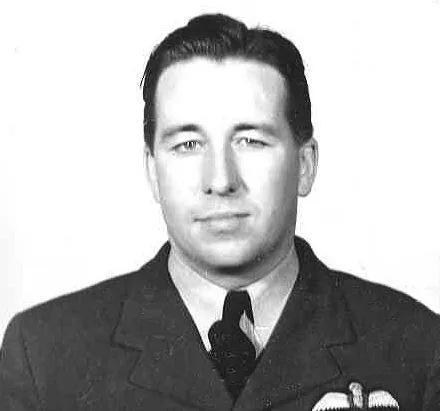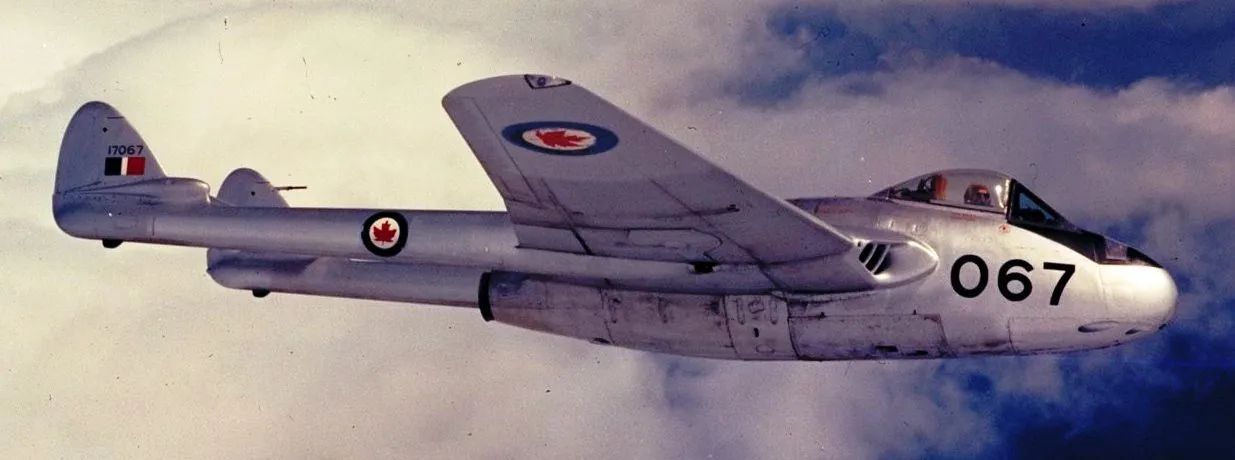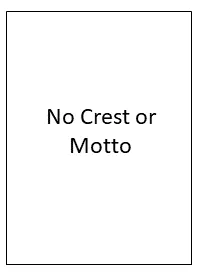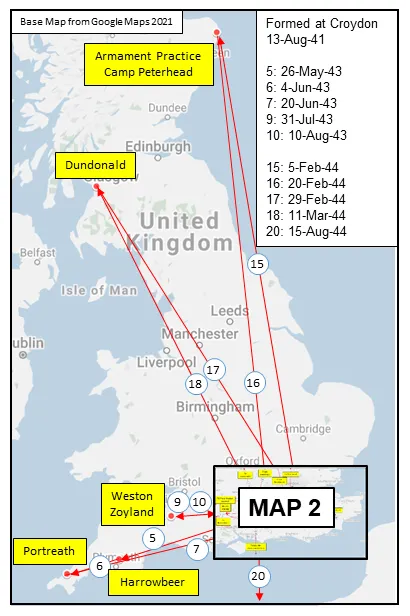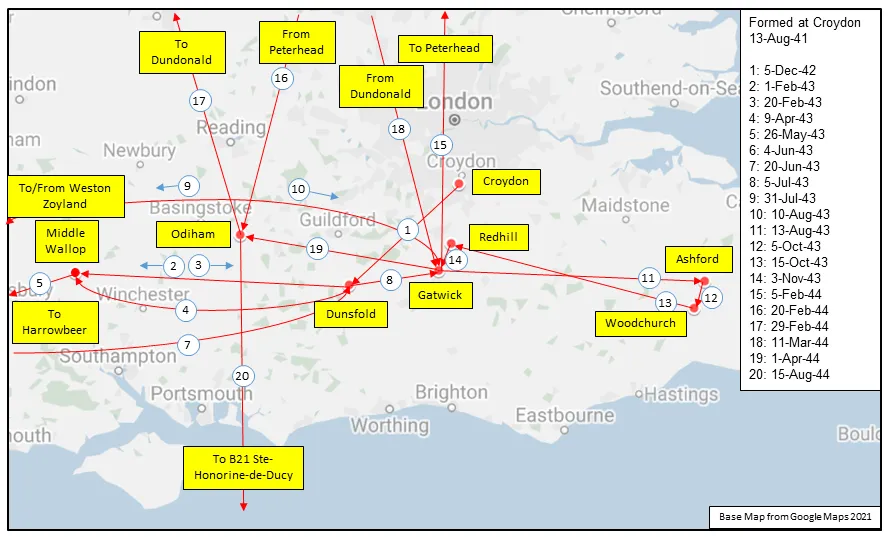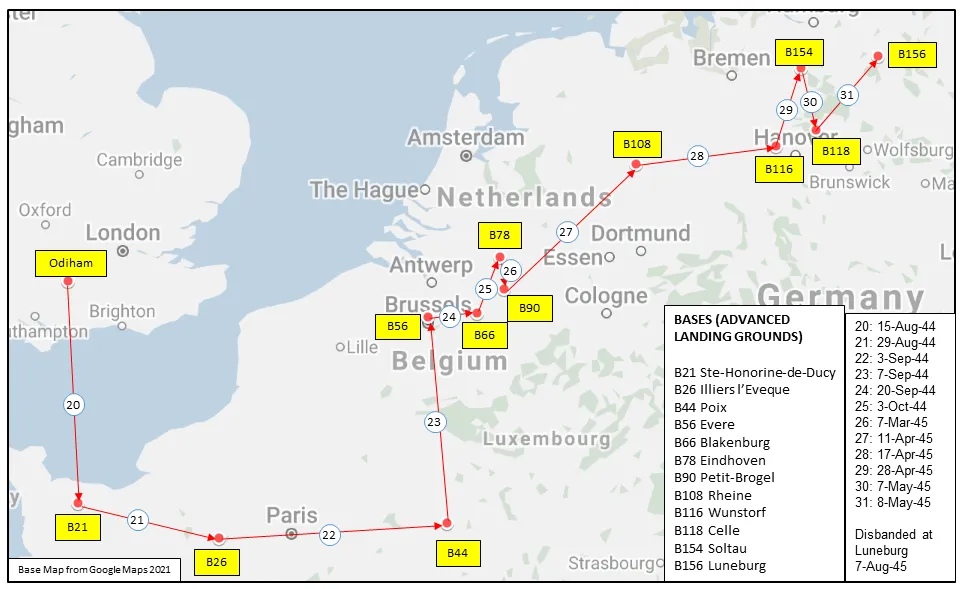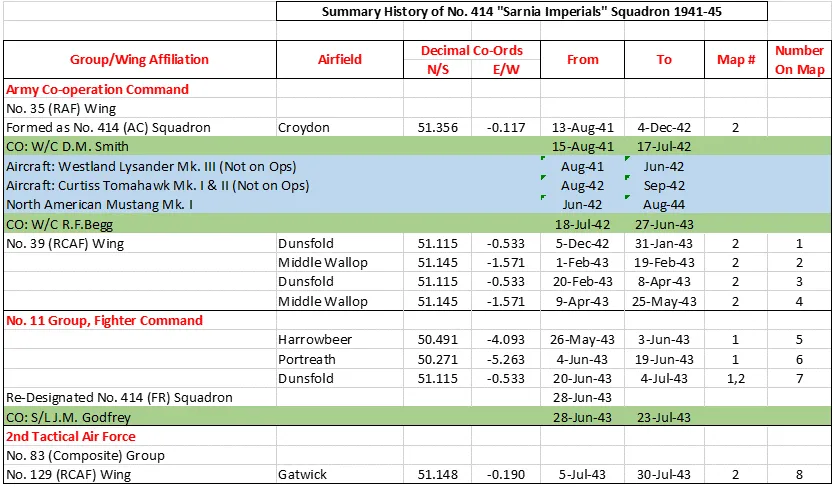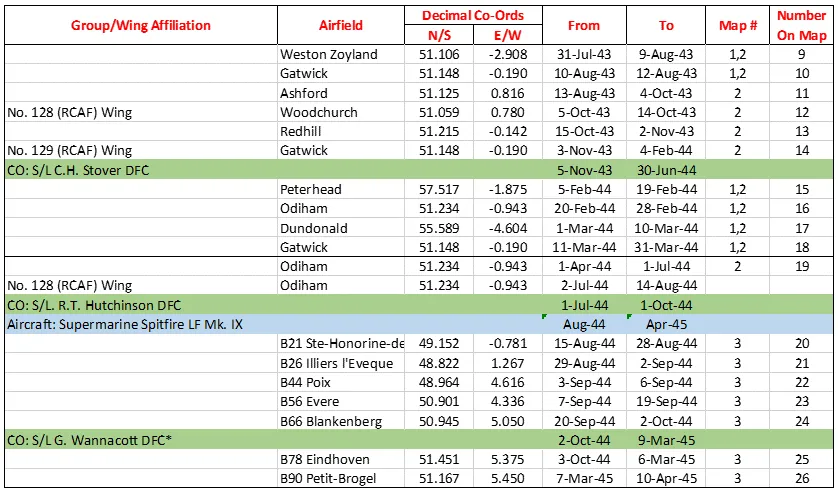Source: Harold A Skaarup Web Page (DND Photo via James Craik)
de Havilland DH.100 Vampire, RCAF (Serial No. 17067), No. 411 "County of York" Squadron (Auxiliary), Toronto, Ontario
The de Havilland Vampire is a British jet fighter which was developed and manufactured by the de Havilland Aircraft Company. It was the second jet fighter to be operated by the RAF, after the Gloster Meteor, and the first to be powered by a single jet engine.
Development of the Vampire as an experimental aircraft began in 1941 during the Second World War, to exploit the revolutionary innovation of jet propulsion. From the company's design studies, it was decided to use a single-engine, twin-boom aircraft, powered by the Halford H.1 turbojet (later produced as the "Goblin"). Aside from its propulsion system and twin-boom configuration, it was a relatively conventional aircraft. In May 1944 it was decided to produce the aircraft as an interceptor for the Royal Air Force (RAF). In 1946 the Vampire entered operational service with the RAF, only months after the war had ended.
The Vampire quickly proved to be effective and was adopted as a replacement of wartime piston-engined fighter aircraft. During its early service it accomplished several aviation firsts and achieved various records, such as being the first jet aircraft to cross the Atlantic Ocean. The Vampire remained in front-line RAF service until 1953 when it was progressively reassigned to various secondary roles, such as ground attack and pilot training, for which specialist variants were produced. The RAF retired the Vampire in 1966 when its final role of advanced trainer was filled by the Folland Gnat. The Royal Navy had also adapted the type as the Sea Vampire, a navalised variant suitable for operations from aircraft carriers. It was the service's first jet fighter.
The Vampire was exported to a wide variety of nations and was operated worldwide in numerous theatres and climates. Several countries deployed the type in combat during conflicts, including the Suez Crisis, the Malayan Emergency, and the Rhodesian Bush War. By the end of production, almost 3,300 Vampires had been manufactured, a quarter of these having been manufactured under licence in several other countries.
The layout of the DH.100 used a single jet engine installed in an egg-shaped fuselage which was primarily composed of plywood for the forward section and aluminium throughout the aft section. It was furnished with conventional mid-mounted straight wings; air brakes were installed on the wings to slow the aircraft, a feature that had also been incorporated in the Meteor. Armament comprised four 20 mm Hispano Mk V cannon located underneath the nose; from the onset of the design phase, even when the aircraft was officially intended to serve only as an experimental aircraft, the provision for the cannon armament had been included.
In 1946, a single Vampire F.1 began operating on an evaluation basis in Canada at the Winter Experimental Establishment in Edmonton. The Vampire F.3 was selected as one of two types of operational fighters for the Royal Canadian Air Force (RCAF) and was first flown in Canada on 17 January 1948 where it went into service as a Central Flying School training aircraft at RCAF Station Trenton. Operating a total of 86 aircraft, the Vampire F.3 became the first jet fighter to enter RCAF service in any significant numbers.
The Vampire had the function of introducing Canadian fighter pilots not only to jet propulsion, but also to other amenities such as cockpit pressurisation and the tricycle landing gear arrangement. It proved to be a popular aircraft, being easy to fly and often considered a "hot rod". In Canadian service, the Vampire served in both operational and air reserve units (400, 401, 402, 411, 438 and 442 squadrons). During the late 1950s, the type was retired and was replaced in RCAF service by the Canadair Sabre.
Wikipedia
After retirement, 26 of the surplus RCAF Vampires were sold to the Formetal Division of Fliteways Inc., West Bend, Wisconsin, USA in 1958. Another 4 airframes were to provide spares. Aerial Blight Control, also of West Bend, refurbished 15 Vampires for sale to the Mexican Air Force starting in 1959. The FAM operated the Vampires until about 1970. Several of the remaining Vampires purchased by Fliteways found their way to the US civil market. Some may now be found in museums in Mexico, the U.S. or Canada.
 Wikipedia de Havilland Vampire
Wikipedia de Havilland Vampire
 Harold A Skaarup Web Page
Harold A Skaarup Web Page
 YouTube de Havilland Vampire
YouTube de Havilland Vampire
 de Havilland Vampire - Kestrel Publications
de Havilland Vampire - Kestrel Publications
414 (F) Sqn Totis Viribus ("Sarnia Imperials")
History of the Squadron during World War II (Aircraft: Lysander III, Tomahawk I & II, Mustang I, Spitfire X)
Note that during WWII the squadron had no crest nor motto. These were awarded later. The squadron was unofficially known as the “Sarnia Imperialsâ€.
No. 414 Squadron was formed as the RCAF's 12th squadron formed overseas in WWII, at Croydon, Surrey, UK  . It was the second Army Co-operation unit to be formed in this group, and was initiated on 13 August 1941. In the early days, it flew Westland Lysander Mk. III aircraft before flying Curtiss Tomahawk Mks. I and II (both non-operationally). It saw no action in the AC role since no army units were active in Europe. On 28 June 1943 the unit was re-designated a Fighter Reconnaissance unit at Dunsfold, Surrey. Thereafter, the squadron joined the 2nd Tactical Air Force. By now it was flying North American Mustang Mk. I aircraft. The duties were to provide intelligence, such as photographic reconnaissance before and after D-Day, and tactical reconnaissance once the invasion had taken hold. The squadron was issued with Supermarine Spitfire aircraft and moved to France in August 1944, and thereafter followed the Allied armies in their progress through France, the Low Countries and Germany, providing reconnaissance for them. The squadron was disbanded at Luneburg, Germany
. It was the second Army Co-operation unit to be formed in this group, and was initiated on 13 August 1941. In the early days, it flew Westland Lysander Mk. III aircraft before flying Curtiss Tomahawk Mks. I and II (both non-operationally). It saw no action in the AC role since no army units were active in Europe. On 28 June 1943 the unit was re-designated a Fighter Reconnaissance unit at Dunsfold, Surrey. Thereafter, the squadron joined the 2nd Tactical Air Force. By now it was flying North American Mustang Mk. I aircraft. The duties were to provide intelligence, such as photographic reconnaissance before and after D-Day, and tactical reconnaissance once the invasion had taken hold. The squadron was issued with Supermarine Spitfire aircraft and moved to France in August 1944, and thereafter followed the Allied armies in their progress through France, the Low Countries and Germany, providing reconnaissance for them. The squadron was disbanded at Luneburg, Germany  on August 7, 1945.
on August 7, 1945.
In the course of WWII the squadron flew over 6,000 sorties for the loss of 23 pilots, 19 of whom were killed or missing, the remaining 4 being POWs. They claimed 29 enemy aircraft destroyed, 1 probable and 11 damaged. On ground attack, they accounted for 76 locomotives and other miscellaneous targets. The squadron produced one ace, Flight Lieutenant D.I. Hall DFC. Awards gained were 2 Bars to DFC, 16 DFCs and 3 MiD. Battle Honours were:Defence of Britain 1942-43, Fortress Europe 1942-44, Dieppe, France and Germany 1944-45: Normandy 1944, Arnhem Rhine, Biscay 1943Wikipedia, Kostenuk and Griffin
Maps for Movements of 414 Squadron 1941-45
MAP 1: 414 Squadron Movements in Britain 1941-44 (right-click on image to display enlarged in new tab)
|
MAP 2: 414 Squadron Movements Detail of Map 1
|
MAP 3: 414 Squadron Movements in Europe 1944-45
414 Squadron History Summary 1941-45
414 Squadron History Summary 1941-45 Page 2
414 Squadron History Summary 1941-45 Page 3
History of the Squadron Post-WWII (Aircraft: Dakota IIIP & IVP, Sabre 4, 5, 6, Canuck, Voodoo, Silver Star)
Unofficially, No. 14 (Photographic) Squadron at Rockcliffe (Ottawa), Ontario  was formed on 12 June 1944, and it was officially renumbered No. 414 on 1 April 1947. The squadron flew Douglas Dakota IIP and IVP aircraft on vertical photographic duty, to photograph 323,754 square miles (838,520 km2) of Canada's North. When this task was completed the squadron was disbanded on 1 November 1950.
was formed on 12 June 1944, and it was officially renumbered No. 414 on 1 April 1947. The squadron flew Douglas Dakota IIP and IVP aircraft on vertical photographic duty, to photograph 323,754 square miles (838,520 km2) of Canada's North. When this task was completed the squadron was disbanded on 1 November 1950.
The squadron was re-formed as a Fighter unit at Bagotville, Quebec  on 1 November 1952, equipped with Canadair Sabre aircraft. It later joined No. 4 (Fighter) Wing at Baden-Soellingen, Germany
on 1 November 1952, equipped with Canadair Sabre aircraft. It later joined No. 4 (Fighter) Wing at Baden-Soellingen, Germany  in August 1953. In 1956, it was decided to replace one Sabre squadron in each of No. 1 Air Division Europe’s four wings with an all-weather fighter unit. When No. 419 AW(F) Squadron arrived from Canada, No. 414 was deactivated on 14 July 1957 and reactivated as All-Weather (Fighter) at North Bay, Ontario
in August 1953. In 1956, it was decided to replace one Sabre squadron in each of No. 1 Air Division Europe’s four wings with an all-weather fighter unit. When No. 419 AW(F) Squadron arrived from Canada, No. 414 was deactivated on 14 July 1957 and reactivated as All-Weather (Fighter) at North Bay, Ontario  on 5 August 1957. The squadron flew CF-100 and CF-101 aircraft on North American air defence until disbanded on 30 June 1964.
on 5 August 1957. The squadron flew CF-100 and CF-101 aircraft on North American air defence until disbanded on 30 June 1964.
The squadron re-formed once again at RCAF Station St-Hubert, Quebec  , on September 15, 1967 as 414 Electronic Warfare Squadron, with CF-100 aircraft. The unit provided Air Defence Command ground control radar personnel and airborne interceptor crews with training and experiences in combating radar jamming. On 1 February 1968 the squadron was integrated into the Canadian Armed Forces. In August 1972, 414 moved to Canadian Forces Base North Bay and stayed there until 1992, when they were split in two with one part going to Canadian Forces Base Comox, British Columbia
, on September 15, 1967 as 414 Electronic Warfare Squadron, with CF-100 aircraft. The unit provided Air Defence Command ground control radar personnel and airborne interceptor crews with training and experiences in combating radar jamming. On 1 February 1968 the squadron was integrated into the Canadian Armed Forces. In August 1972, 414 moved to Canadian Forces Base North Bay and stayed there until 1992, when they were split in two with one part going to Canadian Forces Base Comox, British Columbia  as 414 Composite Squadron and the other part going to Canadian Forces Base Shearwater, Nova Scotia as 434 Composite Squadron. 414 changed its name to Combat Support Squadron in 1993 when it was equipped with the CT-133 Silver Star. In 2002, 414 Squadron was disbanded and its remaining two aircraft retired.
as 414 Composite Squadron and the other part going to Canadian Forces Base Shearwater, Nova Scotia as 434 Composite Squadron. 414 changed its name to Combat Support Squadron in 1993 when it was equipped with the CT-133 Silver Star. In 2002, 414 Squadron was disbanded and its remaining two aircraft retired.
On 7 December 2007 approval was received for the squadron to stand up once more, this time as 414 EWS (Electronic Warfare Support) Squadron. Belonging to the RCAF Aerospace Warfare Centre, the squadron is based in Ottawa and is composed of military Electronic Warfare Officers who fulfill the combat support role, flying on civilian contracted aircraft.
